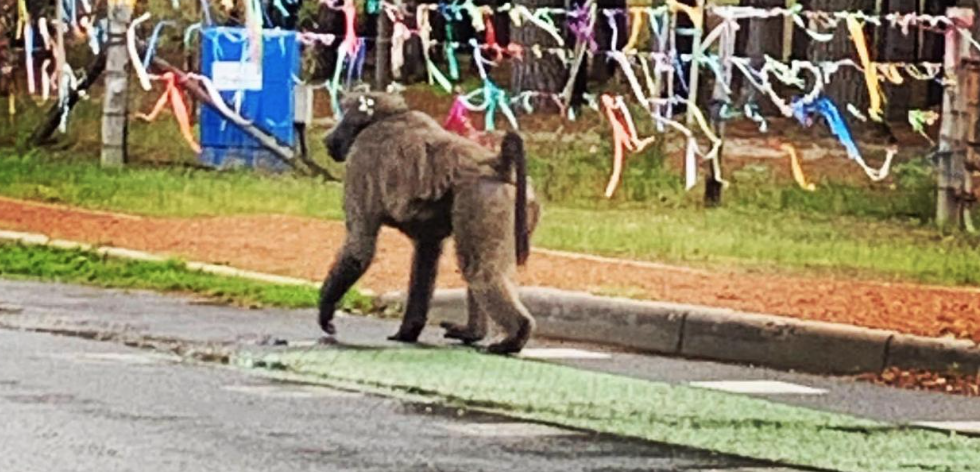The City of Cape Town is aware of the conflict between humans and baboons, particularly the issues that have arisen from the relocation of a male baboon named Kataza and the tensions it has caused with animal activists. The baboon was moved from his home Slangkop troop to Tokai, and animal activists have been working tirelessly to unite him with his family.
“I am aware that some animal activists do not agree with the recent relocation of a male baboon from the Slangkop Troop to Tokai. This male was born in the Slangkop Troop and commenced to inbreed. He was also splintering the group and compromising the welfare of the whole troop. Being young and healthy, it was decided to relocate him to the northern sub-population where his chances of outbreeding are greatly improved, and with that, the genetic health of any offspring,” City’s Mayco Member for Spatial Planning and Environment, Marian Nieuwoudt, said.
“The male baboon was sighted by baboon rangers where he was interacting with several female baboons in the Tokai Troop on Sunday, August 30. Unfortunately, we have been informed that animal activists have since attempted to lure the male baboon back to Kommetjie during the course of September 1.”
The City of Cape Town’s Baboon Programme has to date recorded an increase of 80% in the Cape Peninsula’s baboon population since 2006, excluding the troops inside Cape Point National Park. According to the City, this affirms the success of a programme that is being replicated by countries around the world.
This is an increase of 197 baboons within 14 years and is equivalent to six new troops with an average of 30 baboons living alongside Cape Town’s suburbs.
“The increase in the baboon population affirms the City’s approach in allocating resources to prevent baboons from entering urban areas as far as possible,” said Nieuwoudt.
The City’s Baboon Programme is internationally recognised and countries such as Israel, the United Kingdom, Australia and Saudi Arabia are replicating the programme’s methodology.
Input regarding challenges are sought and received from conservation, animal welfare and wildlife professionals at CapeNature, SANParks, Cape of Good Hope SPCA and the University of Cape Town’s Institute for Communities and Wildlife in Africa. This collective is known as the Baboon Technical Team.
The team advises the City on decisions impacting the troops that live alongside the suburbs. The City also has regular operational meetings with the service provider, and follows the Guidelines for Baboon Management which have been developed over the past decade in accordance with international best practice.
The City also meets twice a year with members of the public through the Council appointed representatives of baboon suburbs, known as CARBS, to inform stakeholders and to address any concerns.
“The chacma baboon, or Papio ursinus, is integral to the Peninsula’s rich biodiversity and also plays a significant ecological role in the Cape Floristic Region. I want to assure every resident, animal activist, and visitor that the City is committed to maintaining a sustainable baboon population in the Cape Peninsula. To do so, we have to minimise conflict between people and baboons, and try to keep them out of the urban environment, which is dangerous to their general wellbeing,” added Nieuwoudt.
The City’s Baboon Technical Team strives to keep baboons out of urban areas to reduce conflict between humans and baboons; to stop all activities that previously brought people into close contact with baboons; to support the policing and law enforcement of all national, provincial and local laws relating to the protection of wild animals; and to consult regularly with independent local and international baboon experts who have conducted research to inform guidelines.
International and local researchers recommend:
– that baboons be kept out of urban areas;
– that baboon field rangers are trained in field techniques, public education and in law enforcement;
– that field rangers be equipped with aversion tools to discourage baboons from foraging in suburbs and recreational areas; and
– that electrified fence barriers be used where possible to allow baboons to live peacefully next to suburbs.
“Again, I want to urge animal activists to please work with the City, and not to undermine what we are trying to achieve. In the end, we all want to see that the baboon troops are safe and healthy in their natural habitat, as opposed to foraging in urban areas where they are exposed to many dangers,” Nieuwoudt said.
Picture: Bring Kataza Back/Facebook

